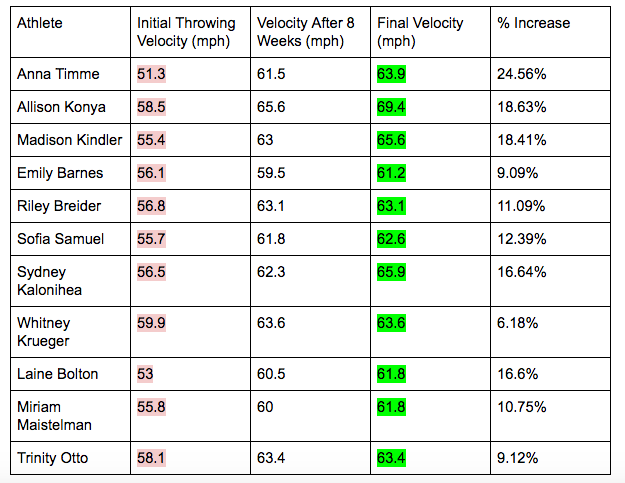Implementation of Weighted Balls for Softball Athletes
As weighted balls have taken over the velocity building landscape in baseball, the question begged to answered, “how can this be implemented for fastpitch softball athletes?”.
With the average throwing velocity increasing every year, the importance of being able to throw hard is only going to increase in softball as well.
Over the past 5 months, we have used throwing protocols from various successful throwing programs as well as a few of our own to help remap arm paths, improve throwing velocity, reduce overall arm pain and improve arm health.
Remapping Arm Paths
One of the most neglected things in fastpitch softball is still the lack of efficient arm paths seen across all levels of the sport. The true cause of this is not completely known, but we theorize that it comes from a few factors such as lack of intent as well as an emphasis on accuracy over velocity in youth softball. This often results in poor throwing mechanics and specific issues such as the elbow dropping below the line of the shoulder and protruding, leading to stress and pain in the elbow.
With our athletes, before any velocity could be built, many of their arm paths had to be reworked from the ground up, to reduce pain and risk of injury throughout the rest of the throwing program. During this phase, we focused on a few important movements and “checkpoints” throughout the completion of the throw.
Scapular Loading
Quite possibly the most important of any of the movements, this allows the arm to get into the correct position to then fall into external rotation (which we will cover later). This concept was best grasped by our athletes while doing a Driveline Baseball inspired movement known as the “Pivot - Pickoff”. This promotes hip to shoulder separation as well as scapular loading when done correctly.
Another way for our athletes to consciously feel this movement was through another constraint drill known as “pocketing”, first talked by Dave Coggin at PFA Baseball/Softball. This promotes a very shorts and efficient arm path and over-exaggerates the feeling of the scapular load.
Scapular Loading
“Pocketing”
Example of Pivot Pick-Offs
External Rotation
This is an incredibly important part of how the arm moves within an efficient arm path. External rotation allows the arm to “fall back” and create a whip effect as it internally rotates to complete the throwing motion. We see issues with lack of external rotation from many of our athletes who’s throwing arm remains outside a 90 degree angle, drastically limiting the amount of external rotation that can be achieved. By keeping the arm within 90 degrees, as well as using various weighted balls we were able to improve the external rotation of many of our girls, which we strongly believe aided in increasing throwing velocity. Below are various examples of external rotation.
Pronation of the Hand
The final major flaw we see in many softball players is supination of the hand, or throwing through the side of the softball. Occurring during release, this not only does not allow maximum energy to be transferred through the softball, but also causes the ball to “cut” or move glove-side when throwing across the diamond. In order to combat this, we put an emphasis during our drill work of consciously attempting to pronate the hand, creating good habits and staying “through the softball”.
Velocity Building
After all of the girls has corrected and improved their arm paths, building throwing velocity was the next step. With the average high school softball athlete throwing between 52-55mph and the average collegiate athlete throwing 58-60mph (62-64mph for Division 1) we set out to have every girl on our team throwing 60mph.
How?
Our velocity program combined the use of overload and underload training balls as well as softballs with a lifting program in order to build throwing velocity. We believe that throwing differently weighted balls at high velocities not only improves external rotation, but also sequencing of movement patterns and intent. Our athletes would complete various drills that would force them to move their bodies at high rates of speed, prior to throwing differently weighted balls at maximum effort. We believe that the proprioceptive qualities were invaluable as they learned how to move better, and use their kinetic chain efficiently.
This in combination of various different strength and power based movements in the weight room allowed these girls to make drastic improvements athletically that even far exceeded our expectations.
The final results of the throwing program can be seen in the chart below:
Every athlete now has above average arm strength, with some well on their way to “elite” (70mph and up)!
Arm Care
The final, yet most underutilized aspect of youth throwing, especially in softball would have to be the recovery phase. Very rarely if ever do any girls come into our program having previously done any arm care before or after throwing. We instilled the importance of arm care very early in the training process, and as the girls became accustomed to it, arm pain diminished or was completely non-existent.
Our arm care is focused around the concept of strengthening the “decelerators” of the arm (the rotator cuff group, posterior deltoid, latissimus dorsi, as well as the trapezius and biceps). We achieve this through things such as band work, rotator cuff targeting movements, as well as exercises that encourage stabilization of the shoulder, force exception throughout the arm and proprioception.
If arm care is neglected, you are not only doing your athlete a disservice, but putting them at higher risk of injury.













